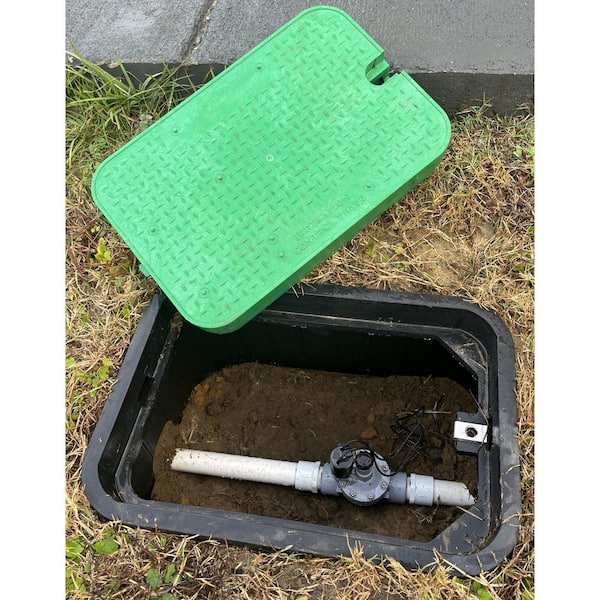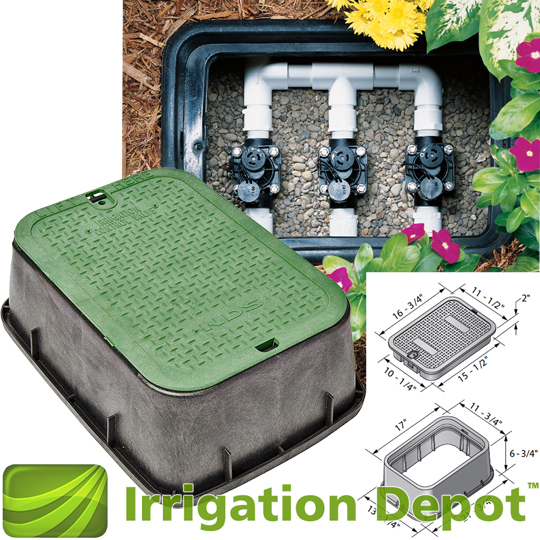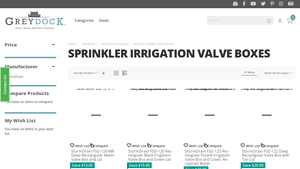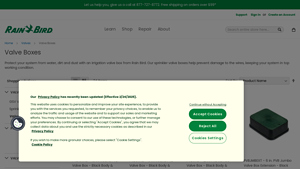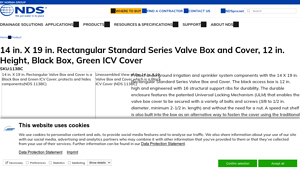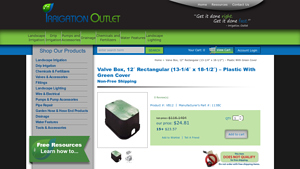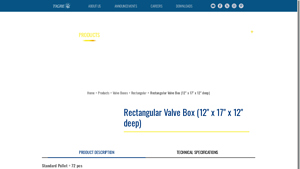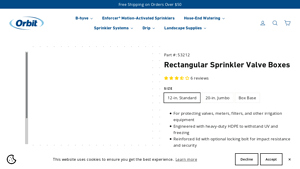Introduction: Navigating the Global Market for rectangular valve box irrigation
In the ever-evolving landscape of agricultural technology, sourcing high-quality rectangular valve box irrigation solutions can pose significant challenges for international B2B buyers. As the demand for efficient irrigation systems grows—especially in regions like Africa, South America, the Middle East, and Europe—understanding the nuances of valve boxes becomes essential for ensuring optimal performance and longevity of irrigation systems. This comprehensive guide addresses various types of rectangular valve boxes, their applications, and the critical factors to consider when vetting suppliers.
From the intricacies of installation to maintenance tips and cost analysis, this resource empowers decision-makers to navigate the complexities of the global market effectively. We delve into the essential features of valve boxes, including their materials, sizes, and compatibility with different irrigation systems, to help buyers make informed choices that align with their specific operational needs.
Furthermore, this guide equips B2B buyers with actionable insights into sourcing strategies, supplier evaluation criteria, and market trends, enabling them to forge strong partnerships and secure the best products for their irrigation projects. Whether you’re operating in Vietnam or Nigeria, the information presented here is designed to enhance your purchasing strategy, ultimately leading to improved efficiency and sustainability in your irrigation endeavors.
Understanding rectangular valve box irrigation Types and Variations
| Type Name | Key Distinguishing Features | Primary B2B Applications | Brief Pros & Cons for Buyers |
|---|---|---|---|
| Standard Rectangular Valve Box | Basic design, typically made from high-density polyethylene | Residential and commercial irrigation systems | Pros: Cost-effective, easy to install. Cons: Limited durability under extreme conditions. |
| Pro-Series Rectangular Valve Box | Enhanced structural integrity, double-wall design | Large-scale agricultural and commercial irrigation | Pros: High durability, suitable for heavy use. Cons: Higher upfront cost. |
| Meter Box with Drop-in Cover | Integrated access for water meter reading, often with a lid | Municipal water management, irrigation monitoring | Pros: Convenient for maintenance, protects meters. Cons: May require specific installation. |
| Sand Box Rectangular Valve Box | Designed for reclaimed water systems, often with a sand cover | Reclaimed water irrigation systems | Pros: Specialized for reclaimed water, prevents contamination. Cons: Niche application, limited availability. |
| Green Lid Rectangular Valve Box | Color-coded for easy identification of non-potable water systems | Landscaping, parks, and public spaces | Pros: Enhances safety by indicating water type. Cons: May be more expensive than standard models. |
What Are the Characteristics of Standard Rectangular Valve Boxes?
Standard rectangular valve boxes are the most common type used in both residential and commercial irrigation systems. Typically constructed from high-density polyethylene, these boxes offer a basic design that is lightweight yet functional. Their primary advantage lies in their cost-effectiveness, making them suitable for budget-conscious projects. However, buyers should consider the potential limitations in durability, especially in harsh environmental conditions.
How Do Pro-Series Rectangular Valve Boxes Stand Out?
Pro-Series rectangular valve boxes are designed with enhanced structural integrity, featuring a double-wall construction that provides superior durability. These boxes are ideal for large-scale agricultural and commercial irrigation applications where heavy use and weather extremes are a concern. While they come with a higher initial investment, their long-term performance can lead to cost savings through reduced maintenance and replacement needs.
What Are the Benefits of Meter Boxes with Drop-in Covers?
Meter boxes with drop-in covers serve a dual purpose by providing access for water meter readings while safeguarding the underlying valves. This design is particularly beneficial for municipal water management and irrigation monitoring. The convenience of easy maintenance is a significant advantage, although buyers should be aware that these boxes may require specific installation techniques to ensure proper functionality.
In What Scenarios Are Sand Boxes Used?
Sand box rectangular valve boxes are specifically designed for reclaimed water systems, often featuring a sand cover to prevent contamination. These boxes are crucial in settings where reclaimed water is utilized for irrigation, ensuring safe and effective water management. Although they serve a niche application, their specialized design makes them indispensable for projects focused on sustainability and resource conservation.
Why Choose Green Lid Rectangular Valve Boxes?
Green lid rectangular valve boxes are color-coded to indicate non-potable water systems, enhancing safety in landscaping, parks, and public spaces. This feature is particularly important in environments where the risk of accidental contamination is high. While they may come at a premium compared to standard models, the added safety benefits and compliance with local regulations can justify the investment for many buyers.
Key Industrial Applications of rectangular valve box irrigation
| Industry/Sector | Specific Application of rectangular valve box irrigation | Value/Benefit for the Business | Key Sourcing Considerations for this Application |
|---|---|---|---|
| Agriculture | Used in large-scale irrigation systems for crops | Enhances water management efficiency, reducing waste | Sourcing durable materials to withstand environmental conditions |
| Landscaping & Turf Management | Provides access to valves in commercial landscaping | Facilitates maintenance and reduces downtime | Ensure compatibility with various valve types and sizes |
| Municipal Water Supply | Protects control valves in municipal irrigation systems | Ensures reliable water distribution and access | Compliance with local regulations and standards |
| Golf Course Management | Manages irrigation for greens and fairways | Optimizes water usage and improves turf health | Consideration for aesthetic design and durability |
| Industrial Parks | Supports irrigation in landscaped areas of industrial zones | Enhances property aesthetics and maintenance access | Bulk purchasing options and long-term supply agreements |
How is Rectangular Valve Box Irrigation Used in Agriculture?
In the agriculture sector, rectangular valve boxes are crucial for managing irrigation systems in large farming operations. They provide a protective enclosure for control valves, enabling easy access for maintenance and adjustments. This application is vital for optimizing water usage, especially in regions prone to drought, such as parts of Africa and the Middle East. Buyers should prioritize sourcing durable materials that can withstand harsh weather conditions and ensure compatibility with existing irrigation systems to maximize efficiency.
What Role Does Rectangular Valve Box Irrigation Play in Landscaping & Turf Management?
In landscaping and turf management, rectangular valve boxes are employed to safeguard irrigation valves in commercial properties and parks. This application allows for quick maintenance access, significantly reducing downtime and operational disruptions. For businesses in South America and Europe, selecting valve boxes that align with local climate conditions and landscaping designs is essential. Buyers should also consider the aesthetic aspects, ensuring the boxes blend seamlessly with the landscape.
How is Rectangular Valve Box Irrigation Beneficial for Municipal Water Supply?
Municipal water supply systems utilize rectangular valve boxes to protect and manage control valves within irrigation networks. This application is critical for ensuring the reliability of water distribution, particularly in urban areas facing increasing water demand. International buyers must ensure that the valve boxes comply with local regulations and standards to maintain system integrity and public safety. Additionally, sourcing from reputable manufacturers can enhance the longevity and performance of these essential components.
In What Ways Do Golf Courses Utilize Rectangular Valve Box Irrigation?
Golf courses leverage rectangular valve boxes to manage irrigation systems effectively across greens and fairways. This application is vital for optimizing water usage, thereby improving the health and appearance of the turf. Businesses in the golf industry, especially in regions with variable climates, should focus on sourcing valve boxes that offer durability and ease of access for maintenance. Aesthetic considerations also play a role, as these boxes should complement the overall design of the course.
What Importance Does Rectangular Valve Box Irrigation Have for Industrial Parks?
In industrial parks, rectangular valve boxes facilitate the irrigation of landscaped areas, enhancing the property’s aesthetic appeal and environmental quality. This application helps businesses maintain green spaces that can improve employee morale and attract potential clients. When sourcing valve boxes for industrial applications, buyers should consider bulk purchasing options and establish long-term supply agreements to ensure consistent availability and cost-effectiveness.
3 Common User Pain Points for ‘rectangular valve box irrigation’ & Their Solutions
Scenario 1: Difficulty in Accessing Valves for Maintenance
The Problem: B2B buyers often face challenges when it comes to accessing irrigation valves buried beneath rectangular valve boxes. In regions with high soil density or uneven terrain, it can become a labor-intensive task to locate and maintain these valves. This not only increases labor costs but can also lead to prolonged downtime for the irrigation system, which is critical for agricultural or landscaping operations. Moreover, if the valve box is too small or improperly installed, maintenance becomes even more cumbersome, resulting in frustration and inefficiency.
The Solution: To alleviate this issue, buyers should prioritize selecting appropriately sized rectangular valve boxes that provide ample space for valve access and maintenance. A box that is too small can complicate repairs and replacements, necessitating additional excavation work. It is advisable to choose boxes with removable tops and built-in slots for pipes, which allow for quicker access to valves without the need for digging. Furthermore, consider using modular systems that can accommodate future expansions or changes in the irrigation setup. Partnering with suppliers who offer installation guides and maintenance tips can further ensure that the rectangular valve boxes are installed correctly from the outset, minimizing future access issues.
Scenario 2: Valve Box Damage from Environmental Factors
The Problem: Rectangular valve boxes are often exposed to harsh environmental conditions, such as extreme temperatures, heavy rainfall, or localized flooding. In many regions, particularly in Africa and South America, these weather conditions can lead to the degradation of valve boxes, causing them to crack or warp. This not only compromises the integrity of the valve box but also exposes the valves to potential damage and failure, which can have costly repercussions for irrigation systems that rely on these components.
The Solution: To combat these environmental challenges, buyers should invest in high-quality rectangular valve boxes made from durable materials designed to withstand extreme conditions. Look for products that are UV-resistant and constructed from high-density polyethylene or other robust materials that offer enhanced longevity. Additionally, consider installing the valve boxes at a slightly elevated position to prevent water accumulation and reduce the risk of flooding. Regular inspections and maintenance, such as checking for cracks or signs of wear, can help identify issues early and prevent more significant damage down the line.
Scenario 3: Inefficiencies in System Performance Due to Valve Mismanagement
The Problem: One common pain point for B2B buyers is the inefficiency of irrigation systems caused by improper valve management. Mismanagement can stem from inadequate sizing of the rectangular valve box, leading to difficulties in monitoring and controlling water flow. This inefficiency not only increases water usage but can also result in uneven irrigation coverage, affecting crop yields or landscape aesthetics. In regions where water resources are scarce, such inefficiencies can have significant financial and environmental impacts.
The Solution: Buyers can enhance the performance of their irrigation systems by ensuring that the rectangular valve boxes are properly sized for the number of valves they house. A larger box allows for better organization of valves and easier installation of additional components like manifold systems. Furthermore, implementing smart irrigation technology can greatly aid in managing valves effectively. Automated systems that monitor soil moisture levels and weather conditions can optimize water usage and ensure that irrigation occurs only when necessary. Training staff on best practices for valve management and maintenance can also improve the efficiency and longevity of the irrigation system, ultimately leading to better resource management and cost savings.
Strategic Material Selection Guide for rectangular valve box irrigation
What are the Key Properties of Common Materials Used in Rectangular Valve Box Irrigation?
When selecting materials for rectangular valve boxes in irrigation systems, it is essential to consider their properties to ensure optimal performance. The most common materials include high-density polyethylene (HDPE), polypropylene, fiberglass, and concrete. Each material has unique characteristics that influence its suitability for specific applications.
High-Density Polyethylene (HDPE)
HDPE is a popular choice due to its excellent strength-to-weight ratio and resistance to corrosion. It can withstand a wide range of temperatures, making it suitable for various climates. Additionally, HDPE is resistant to chemicals, which is crucial in irrigation systems that may involve fertilizers or other corrosive substances.
Pros: HDPE is lightweight, durable, and easy to install. Its resistance to UV radiation ensures longevity in outdoor applications.
Cons: While HDPE is cost-effective, it may not withstand extreme temperatures as well as some other materials, which could limit its application in areas with harsh climates.
Impact on Application: HDPE is compatible with various media, including reclaimed water, making it an excellent choice for eco-friendly irrigation solutions.
Considerations for International Buyers: Buyers from regions like Africa and the Middle East should ensure that HDPE products comply with local regulations and standards, such as ASTM or DIN, to guarantee quality and safety.
Polypropylene
Polypropylene is another thermoplastic material known for its chemical resistance and lightweight nature. It offers good impact resistance and can handle moderate temperatures, making it suitable for many irrigation applications.
Pros: Polypropylene is cost-effective and can be molded into various shapes, allowing for flexibility in design.
Cons: It may not be as durable as HDPE when exposed to UV radiation unless treated, leading to potential degradation over time.
Impact on Application: This material is suitable for systems that do not require extreme durability but still need to handle various chemicals.
Considerations for International Buyers: Buyers should verify that polypropylene products meet local standards, especially in regions with stringent agricultural regulations, such as Europe.
Fiberglass
Fiberglass is known for its exceptional strength and durability, making it ideal for heavy-duty applications. It can withstand high temperatures and pressures, making it suitable for various environments.
Pros: Fiberglass is highly resistant to corrosion and does not degrade when exposed to UV light, ensuring a long lifespan.
Cons: The manufacturing process for fiberglass can be complex and costly, which may increase the overall price of the product.
Impact on Application: Fiberglass is particularly useful in areas with extreme weather conditions or where high durability is required.
Considerations for International Buyers: Buyers should consider the higher cost of fiberglass and ensure it meets international standards for safety and performance.
Concrete
Concrete is a traditional material known for its strength and durability. It is often used in permanent installations where high load-bearing capacity is required.
Pros: Concrete is highly durable and offers excellent resistance to environmental factors, making it suitable for long-term applications.
Cons: The weight of concrete can complicate transportation and installation, leading to higher logistical costs.
Impact on Application: Concrete is ideal for large-scale irrigation systems that require substantial support and protection for valves.
Considerations for International Buyers: Buyers should be aware of the local availability of concrete and any necessary compliance with construction standards in their region.
Summary Table of Material Selection for Rectangular Valve Box Irrigation
| Material | Typical Use Case for rectangular valve box irrigation | Key Advantage | Key Disadvantage/Limitation | Relative Cost (Low/Med/High) |
|---|---|---|---|---|
| High-Density Polyethylene (HDPE) | Eco-friendly irrigation systems, reclaimed water applications | Lightweight, durable, UV resistant | Limited performance in extreme temperatures | Low |
| Polypropylene | General irrigation systems requiring chemical resistance | Cost-effective, flexible design | UV degradation without treatment | Low |
| Fiberglass | Heavy-duty applications in extreme weather conditions | High durability, excellent corrosion resistance | Complex manufacturing process, higher cost | High |
| Concrete | Large-scale, permanent irrigation installations | Exceptional strength and durability | Heavy, complicates logistics | Medium |
This analysis provides a comprehensive overview of the materials commonly used in rectangular valve box irrigation, highlighting their properties, advantages, and considerations for international B2B buyers. Understanding these factors can help buyers make informed decisions tailored to their specific needs and regional requirements.
In-depth Look: Manufacturing Processes and Quality Assurance for rectangular valve box irrigation
What Are the Main Stages in the Manufacturing Process of Rectangular Valve Boxes for Irrigation?
The manufacturing process of rectangular valve boxes involves several critical stages designed to ensure the final product meets the required standards of durability and functionality. These stages include material preparation, forming, assembly, and finishing.
Material Preparation
The process begins with the selection of high-quality materials, typically high-density polyethylene (HDPE) or polypropylene. These materials are favored for their resistance to corrosion, UV light, and impact, which are vital for irrigation applications. During this stage, raw materials are sourced from certified suppliers, and batches are tested for consistency in quality.
Once materials are approved, they are processed into pellets or sheets. This involves drying and blending them with additives to enhance properties like flexibility and strength. Quality control checks are conducted to ensure that the materials meet the specifications required for robust performance.
How Are Rectangular Valve Boxes Formed?
The next step is forming, where the prepared materials are shaped into valve box components. This is typically achieved through various manufacturing techniques, including injection molding and rotational molding.
Injection Molding: In this method, heated materials are injected into a mold under high pressure. This technique allows for precise control over dimensions and surface finish, making it ideal for producing complex shapes with tight tolerances.
Rotational Molding: This technique involves heating materials in a mold that is rotated on multiple axes. It is particularly effective for creating larger, hollow components and is often used for making valve boxes that require a more substantial structure.
Both methods are closely monitored to maintain quality and consistency.
What Does the Assembly Process Entail?
After forming, the individual components are assembled. This stage may include the installation of internal fittings such as pipe slots and lids. Assembly is often automated, reducing human error and increasing efficiency.
During assembly, quality checks are performed to verify that all components fit correctly and that there are no defects. Any discrepancies are rectified immediately to avoid issues in the final product.
What Finishing Techniques Are Used for Rectangular Valve Boxes?
Finishing is the final manufacturing stage, which enhances the valve box’s aesthetic and functional properties. This may involve surface treatments, such as UV stabilizers to prevent degradation from sunlight exposure, or coatings to improve resistance to chemicals.
The finishing stage also includes labeling and packaging. Products are marked with relevant information, including material composition and compliance standards. Proper packaging is essential to prevent damage during transport, ensuring that products arrive at their destination in optimal condition.
How Is Quality Assurance Ensured in the Manufacturing of Rectangular Valve Boxes?
Quality assurance (QA) is integral to the manufacturing process of rectangular valve boxes. It ensures that products meet international and industry-specific standards, enhancing reliability and performance for end-users.
What International Standards Govern Quality Control?
Manufacturers of rectangular valve boxes often adhere to international standards like ISO 9001, which sets the criteria for a quality management system. This certification demonstrates a commitment to quality and continuous improvement.
In addition to ISO standards, specific industry certifications such as CE marking (indicating conformity with health, safety, and environmental protection standards) and API standards (for products related to the oil and gas industry) may also be relevant. These certifications help B2B buyers ensure that products are safe and reliable for use in irrigation systems.
What Are the Key Quality Control Checkpoints?
Quality control is implemented at various stages of the manufacturing process, including:
Incoming Quality Control (IQC): This initial checkpoint involves inspecting raw materials for conformity to specifications before they enter the production line.
In-Process Quality Control (IPQC): Throughout the manufacturing stages, regular inspections are conducted to identify any issues early on. This includes monitoring the forming and assembly processes.
Final Quality Control (FQC): Before products are shipped, a comprehensive final inspection is performed. This includes testing for functionality, durability, and compliance with relevant standards.
What Common Testing Methods Are Used?
Manufacturers employ various testing methods to ensure quality, including:
Dimensional Testing: To verify that the valve boxes meet specified dimensions and tolerances.
Material Testing: To assess the physical and chemical properties of the materials used, ensuring they meet the required standards.
Environmental Testing: This includes UV resistance tests to ensure longevity under sunlight exposure and impact tests to simulate real-world conditions.
How Can B2B Buyers Verify Supplier Quality Control Practices?
For international B2B buyers, especially in regions like Africa, South America, the Middle East, and Europe, verifying supplier quality control practices is crucial to ensure reliable products. Here are some strategies:
What Should Buyers Look for in Supplier Audits?
Conducting supplier audits is one of the most effective ways to assess a manufacturer’s quality control practices. Buyers should request documentation of past audits, certifications, and compliance with international standards.
How Can Buyers Use Reports and Third-Party Inspections?
Requesting regular quality control reports from suppliers can provide insights into their manufacturing processes and adherence to standards. Additionally, engaging third-party inspection services can offer an unbiased assessment of the supplier’s quality assurance practices.
What Are the QC and Certification Nuances for International Buyers?
International buyers should be aware of the specific regulatory requirements and certifications relevant to their regions. For example, certain countries may require additional certifications for irrigation products. Understanding these nuances can help buyers avoid compliance issues and ensure that they are sourcing products that meet local standards.
In conclusion, an in-depth understanding of the manufacturing processes and quality assurance practices for rectangular valve boxes is vital for B2B buyers. This knowledge not only aids in selecting reliable suppliers but also ensures that the irrigation systems they invest in are efficient, durable, and compliant with international standards.
Practical Sourcing Guide: A Step-by-Step Checklist for ‘rectangular valve box irrigation’
Introduction
This practical sourcing guide serves as a comprehensive checklist for B2B buyers looking to procure rectangular valve boxes for irrigation systems. Selecting the right valve box is essential for ensuring the longevity and efficiency of your irrigation setup, as these components protect vital valves and facilitate maintenance. This guide will walk you through the critical steps to make informed purchasing decisions.
Step 1: Define Your Technical Specifications
Begin by outlining the technical specifications required for your irrigation system. Consider factors such as the dimensions of the valve box, the number of valves to be housed, and the environmental conditions it will face. This clarity will help you identify products that meet your operational needs and avoid costly mistakes.
- Dimensions: Ensure the box is spacious enough to accommodate your valves comfortably.
- Material: Look for durable materials that can withstand local weather conditions.
Step 2: Research Reputable Suppliers
Investigating potential suppliers is crucial in sourcing quality products. Focus on companies that specialize in irrigation equipment, as they will have a better understanding of your specific needs. Make sure to check their market reputation, customer reviews, and industry certifications.
- Certifications: Look for suppliers with relevant quality certifications (e.g., ISO).
- Experience: Evaluate their history in providing irrigation solutions, particularly in your target market.
Step 3: Evaluate Product Quality and Features
Assess the quality of the valve boxes offered by potential suppliers. Key features to consider include water resistance, UV protection, and the design of the lid for easy access. High-quality products can prevent costly repairs and ensure your irrigation system operates smoothly.
- Water Resistance: Ensure the box is designed to protect against moisture infiltration.
- Ease of Access: Look for features like removable lids and built-in pipe slots for maintenance.
Step 4: Request Samples or Specifications
Before finalizing your order, request product samples or detailed specifications from suppliers. This will allow you to physically assess the quality and suitability of the valve boxes for your project. Comparing samples from different suppliers can also help you identify the best option.
- Physical Inspection: Check for durability and design features that meet your needs.
- Compatibility: Ensure the sample fits seamlessly with your existing irrigation components.
Step 5: Negotiate Pricing and Terms
Once you have identified suitable products, engage in negotiations regarding pricing, shipping, and payment terms. Understanding the market price for rectangular valve boxes will empower you during discussions. Don’t hesitate to ask for bulk purchase discounts or flexible payment options.
- Bulk Discounts: Inquire about pricing structures for large orders.
- Payment Flexibility: Consider terms that support your cash flow needs.
Step 6: Verify Supplier Support and Warranty
Confirm the level of customer support and warranty offered by your chosen supplier. Reliable suppliers should provide clear channels for post-purchase support, including troubleshooting and replacement policies. A robust warranty can safeguard your investment against defects.
- Customer Support: Ensure they have a responsive support team.
- Warranty Terms: Review the warranty coverage for the valve boxes.
Step 7: Finalize Your Order and Monitor Delivery
After completing all evaluations and negotiations, finalize your order. Ensure that you have clear documentation of the terms agreed upon. Once the order is placed, monitor the delivery process to ensure timely receipt of your products.
- Documentation: Keep records of your order confirmations and agreements.
- Delivery Tracking: Use tracking tools to stay informed about shipment progress.
By following these steps, B2B buyers can effectively navigate the sourcing process for rectangular valve boxes, ensuring they make informed and strategic purchasing decisions that align with their irrigation needs.
Comprehensive Cost and Pricing Analysis for rectangular valve box irrigation Sourcing
What Are the Key Cost Components for Rectangular Valve Box Irrigation?
When sourcing rectangular valve boxes for irrigation, understanding the detailed cost structure is essential for effective budgeting and decision-making. The primary cost components include:
Materials: The choice of materials significantly impacts pricing. High-density polyethylene (HDPE) and polypropylene are commonly used due to their durability and resistance to environmental factors. Prices can vary based on local availability and market demand.
Labor: This encompasses wages paid to workers involved in manufacturing, assembly, and installation. Labor costs can fluctuate based on geographic location and local labor laws.
Manufacturing Overhead: These are indirect costs associated with production, including utilities, rent for manufacturing facilities, and equipment depreciation. Efficient manufacturing processes can help reduce overhead costs.
Tooling: The initial investment in molds and machinery to produce valve boxes can be substantial. Suppliers often amortize these costs over larger production runs, which can lead to lower unit prices for bulk orders.
Quality Control (QC): Ensuring the reliability and durability of valve boxes requires investments in QC processes. This may involve testing materials and finished products, which adds to the overall cost.
Logistics: Shipping costs can vary widely depending on the mode of transport and distance. International buyers should factor in customs duties and taxes, which can significantly impact the total cost.
Margin: Suppliers will add a margin to cover their operational costs and profit. This margin can vary based on the supplier’s market positioning and competition.
How Do Price Influencers Impact Sourcing Decisions for Rectangular Valve Boxes?
Several factors influence the pricing of rectangular valve boxes, particularly for international B2B buyers:
Volume/MOQ (Minimum Order Quantity): Suppliers often provide better pricing for larger orders. Understanding the minimum order requirements can help buyers negotiate better terms and reduce per-unit costs.
Specifications and Customization: Custom features, such as specific dimensions or colors, can lead to higher costs. Buyers should clearly define their requirements to avoid unexpected price increases.
Materials and Quality Certifications: The use of premium materials and compliance with international quality standards (ISO, ASTM) can increase costs. Buyers should evaluate the trade-off between quality and price to ensure they meet their project specifications without overspending.
Supplier Factors: The reputation and reliability of suppliers can influence pricing. Established suppliers may charge more due to their proven track record, but they may offer better support and product guarantees.
Incoterms: Understanding the International Commercial Terms (Incoterms) is crucial for international transactions. These terms define the responsibilities of buyers and sellers regarding shipping, insurance, and tariffs, affecting overall pricing.
What Buyer Tips Can Help Improve Cost-Efficiency in Valve Box Procurement?
B2B buyers can enhance their sourcing strategies for rectangular valve boxes through several actionable insights:
Negotiation: Leverage volume purchases to negotiate better pricing. Building long-term relationships with suppliers can also lead to favorable terms and discounts.
Total Cost of Ownership (TCO): Consider not just the purchase price but the entire lifecycle cost, including maintenance, durability, and potential replacement costs. Investing in higher-quality products may yield savings over time.
Pricing Nuances for International Buyers: Familiarize yourself with currency fluctuations, import tariffs, and local market conditions. Engaging local suppliers may reduce logistics costs and improve supply chain reliability.
Market Research: Conduct thorough market research to compare supplier offerings. This helps ensure competitive pricing and enhances negotiation leverage.
In conclusion, understanding the cost structure and price influencers while implementing strategic buying practices can significantly benefit B2B buyers in sourcing rectangular valve boxes for irrigation. By focusing on these aspects, buyers can make informed decisions that align with their project requirements and budgetary constraints.
Alternatives Analysis: Comparing rectangular valve box irrigation With Other Solutions
Exploring Alternatives to Rectangular Valve Box Irrigation
In the realm of irrigation solutions, understanding the available alternatives to rectangular valve box irrigation is essential for B2B buyers looking to optimize their systems. This analysis will compare rectangular valve boxes with two viable alternatives: round valve boxes and underground irrigation systems. Each option presents unique advantages and considerations, impacting performance, cost, and ease of implementation.
| Comparison Aspect | Rectangular Valve Box Irrigation | Round Valve Box Irrigation | Underground Irrigation Systems |
|---|---|---|---|
| Performance | High durability and accessibility | Good for compact spaces | Efficient water distribution |
| Cost | Moderate initial investment | Generally lower cost | Higher installation costs |
| Ease of Implementation | Straightforward installation | Easy to install | Complex installation required |
| Maintenance | Accessible for repairs | Similar ease of access | Requires extensive excavation |
| Best Use Case | Large-scale agricultural setups | Residential or small farms | Urban landscaping and gardens |
What Are the Pros and Cons of Round Valve Box Irrigation?
Round valve boxes offer a compact design that fits well in smaller irrigation setups. Their generally lower cost makes them attractive for residential applications or smaller farms. However, they may not provide the same accessibility as rectangular options when it comes to multiple valves or maintenance. Round valve boxes can limit space for repairs and adjustments, particularly in more complex systems.
How Do Underground Irrigation Systems Compare?
Underground irrigation systems represent a sophisticated alternative that integrates the delivery of water directly to plant roots. This method is highly efficient and conserves water by minimizing evaporation. Nevertheless, the initial costs for installation can be significantly higher due to the required excavation and specialized labor. Maintenance can also be challenging, as repairs often necessitate digging up sections of the system. These systems are best suited for urban landscapes or large gardens where aesthetics and efficient water usage are priorities.
Conclusion: Which Irrigation Solution is Right for Your Business?
When choosing the right irrigation solution, B2B buyers must consider their specific operational needs and budget constraints. Rectangular valve box irrigation is ideal for large-scale agricultural applications that demand durability and accessibility. In contrast, round valve boxes serve well in smaller settings, while underground systems excel in efficiency and aesthetics but come with higher costs and maintenance complexities. Assessing these factors against your unique requirements will guide you toward the optimal choice for your irrigation system.
Essential Technical Properties and Trade Terminology for rectangular valve box irrigation
What are the Essential Technical Properties of Rectangular Valve Boxes in Irrigation Systems?
When considering rectangular valve boxes for irrigation systems, understanding their technical properties is crucial for ensuring longevity, efficiency, and compatibility with existing infrastructure. Here are several critical specifications to keep in mind:
Material Grade
The material of the valve box affects its durability and suitability for various environmental conditions. Common materials include high-density polyethylene (HDPE) and polypropylene, both of which offer excellent resistance to UV rays, chemicals, and impact. For B2B buyers, selecting the right material ensures that the valve box can withstand the local climate and operational stresses, thus reducing maintenance costs and extending its lifespan.Dimensions and Size Tolerance
Accurate dimensions are vital for ensuring that the valve box fits the designated space and accommodates the required number of valves. Standard sizes often range from 14 inches by 19 inches to larger configurations, and it’s important to consider size tolerance during manufacturing. A well-fitted valve box allows for easier access during maintenance and reduces the risk of damage to the valves themselves, which can be costly.Load Capacity
The load capacity defines how much weight the valve box can support without deforming or breaking. This specification is particularly important in areas with vehicular traffic or heavy footfall. B2B buyers should ensure that the selected valve box meets or exceeds the expected load requirements to avoid premature failure and associated repair costs.Cover Design and Security Features
Valve box covers come in various designs, including drop-in and bolt-down options. A secure cover prevents unauthorized access and protects the valves from environmental damage. For businesses, investing in robust cover designs enhances safety and reduces the risk of tampering or vandalism, which can lead to service disruptions.Ventilation and Drainage Features
Proper ventilation and drainage are essential for preventing water accumulation inside the valve box, which can lead to corrosion and valve failure. Some designs incorporate drainage slots or vents to facilitate airflow. Ensuring these features are included in the valve box design can significantly enhance the efficiency and reliability of the irrigation system.
What are Common Trade Terms in the Rectangular Valve Box Irrigation Industry?
Familiarity with industry jargon can facilitate smoother transactions and better communication between suppliers and buyers. Here are several key terms:
OEM (Original Equipment Manufacturer)
This term refers to companies that produce parts or equipment that may be marketed by another manufacturer. Understanding OEM relationships can help B2B buyers evaluate the quality and reliability of the valve boxes they are considering.MOQ (Minimum Order Quantity)
MOQ indicates the smallest number of units that a supplier is willing to sell. This is critical for businesses planning to stock inventory, as it affects cash flow and storage considerations. Buyers should negotiate MOQs to align with their operational needs while ensuring they meet supplier requirements.RFQ (Request for Quotation)
An RFQ is a formal process where buyers request price quotes from suppliers for specific products or services. This is essential for securing competitive pricing and understanding the full scope of potential costs, including shipping and handling.Incoterms (International Commercial Terms)
These are standardized trade terms that define the responsibilities of buyers and sellers in international transactions. Familiarity with Incoterms can help businesses navigate shipping logistics and clarify who bears the risk during transit, thus avoiding costly misunderstandings.Lead Time
This refers to the amount of time it takes from placing an order to receiving the product. Understanding lead times is vital for effective project planning and inventory management, especially in regions where supply chain delays may occur.Warranty and Service Agreements
These terms specify the conditions under which the supplier will repair or replace defective products. A solid warranty and service agreement can provide peace of mind for B2B buyers, ensuring that they are protected against unforeseen issues with their valve boxes.
By understanding these technical properties and trade terminologies, international B2B buyers can make informed purchasing decisions, ensuring their irrigation systems operate efficiently and effectively.
Navigating Market Dynamics and Sourcing Trends in the rectangular valve box irrigation Sector
What Are the Key Market Trends in the Rectangular Valve Box Irrigation Sector?
The global market for rectangular valve boxes in irrigation systems is witnessing significant growth, driven by rising demands for efficient water management solutions and sustainable agricultural practices. Key drivers include the increasing need for reliable irrigation systems in regions prone to water scarcity, particularly in Africa and the Middle East, where agricultural productivity is heavily reliant on efficient water usage. Additionally, urbanization in South America and Europe is pushing the demand for advanced irrigation infrastructure to support both residential and commercial landscaping.
Current B2B sourcing trends are increasingly leaning towards technology-driven solutions. The adoption of smart irrigation systems, which integrate IoT technologies, is becoming commonplace. These systems not only enhance the efficiency of water usage but also facilitate remote monitoring and control, making it easier for businesses to manage their irrigation needs effectively. Furthermore, the availability of online platforms for sourcing irrigation components is reshaping procurement processes, allowing international buyers to compare products and suppliers more efficiently.
Emerging market dynamics also reflect a growing preference for durable and high-quality materials in valve box production. Buyers are increasingly aware of the long-term cost implications of their purchases, leading to a shift towards premium products that offer enhanced longevity and performance. This trend is especially pronounced in regions where environmental conditions can accelerate wear and tear on irrigation components.
How Is Sustainability Influencing Sourcing Decisions in the Rectangular Valve Box Irrigation Sector?
Sustainability is becoming a crucial factor in the sourcing of rectangular valve boxes. The environmental impact of manufacturing and disposing of irrigation components is under scrutiny, leading many B2B buyers to prioritize suppliers who demonstrate a commitment to sustainable practices. This includes using recycled materials, such as recycled plastics for valve boxes, which not only reduces waste but also lowers the carbon footprint associated with production.
Furthermore, ethical sourcing is gaining traction, with businesses seeking to establish supply chains that are transparent and socially responsible. Buyers are increasingly looking for suppliers that hold certifications related to environmental sustainability, such as ISO 14001, which signifies a commitment to minimizing environmental impact. Certifications related to material sourcing, such as those indicating the use of non-toxic or biodegradable materials, are also becoming more important in procurement decisions.
As international buyers navigate these sustainability trends, they are encouraged to conduct thorough due diligence on suppliers, assessing their environmental policies and practices. This not only helps in making informed purchasing decisions but also aligns with broader corporate social responsibility goals that many companies are now adopting.
How Has the Rectangular Valve Box Irrigation Sector Evolved Over Time?
The rectangular valve box irrigation sector has evolved significantly over the past few decades. Initially, these components were primarily functional, designed simply to house and protect irrigation valves from environmental damage. However, as irrigation technology advanced, so too did the design and functionality of valve boxes.
Today’s rectangular valve boxes are engineered with enhanced features such as removable tops for easy access, built-in pipe slots for streamlined installation, and materials designed to withstand harsh environmental conditions. This evolution reflects a broader trend within the irrigation sector towards more sophisticated and integrated solutions that not only improve efficiency but also simplify maintenance and reduce operational costs.
The shift towards smart irrigation systems has further accelerated the development of valve boxes, as they now play a critical role in the overall functionality of these advanced systems. As a result, suppliers are continually innovating to meet the changing needs of B2B buyers, ensuring that rectangular valve boxes remain a vital component of modern irrigation setups.
Frequently Asked Questions (FAQs) for B2B Buyers of rectangular valve box irrigation
1. How do I select the right rectangular valve box for my irrigation system?
Choosing the appropriate rectangular valve box is critical for ensuring the longevity and efficiency of your irrigation system. Consider factors such as the number of valves you need to house, the size of the valves, and the environment in which the box will be placed. It’s advisable to opt for a box that allows for adequate space for maintenance and repairs, ideally one that is slightly larger than your requirements. Additionally, look for features like durability, UV resistance, and easy access for servicing.2. What is the best material for rectangular valve boxes used in irrigation?
The best materials for rectangular valve boxes typically include high-density polyethylene (HDPE) and polypropylene. These materials offer excellent durability, resistance to chemicals, and UV protection, making them suitable for various climates. In regions with extreme temperatures or heavy rainfall, selecting a box with double-wall construction can enhance strength and longevity. Always consider the specific environmental conditions and local regulations when selecting materials.3. What are the typical dimensions for rectangular valve boxes in irrigation systems?
Rectangular valve boxes come in various sizes, but common dimensions range from 14 inches by 19 inches to larger options depending on the number of valves and specific requirements. It’s essential to ensure that the box dimensions accommodate not just the valves but also any additional components like manifolds or filters. Accurate measurements are crucial to avoid future complications during installation and maintenance.4. How can I ensure the quality of rectangular valve boxes when sourcing internationally?
To ensure quality when sourcing rectangular valve boxes from international suppliers, vet potential partners thoroughly. Look for manufacturers with certifications such as ISO 9001, which indicates adherence to quality management standards. Request samples to assess the material and build quality. Additionally, consider visiting the manufacturing facility if possible, or utilize third-party inspection services to verify product standards before placing large orders.5. What are the minimum order quantities (MOQs) for rectangular valve boxes?
Minimum order quantities (MOQs) for rectangular valve boxes can vary significantly depending on the supplier and the specific product. Typically, MOQs may range from 50 to 500 units for bulk orders. Some suppliers may offer flexibility with MOQs for first-time buyers or for mixed orders that combine different products. It is advisable to communicate your needs directly with suppliers to negotiate favorable terms.6. What payment terms should I expect when purchasing rectangular valve boxes internationally?
Payment terms can vary widely among international suppliers. Common options include upfront payments, letters of credit, or installment payments based on shipment milestones. Many suppliers may request a deposit (usually 30-50%) upon order confirmation, with the balance due prior to shipment. Always clarify payment methods and terms in advance to avoid misunderstandings and ensure a smooth transaction process.7. What logistics considerations should I keep in mind when importing rectangular valve boxes?
When importing rectangular valve boxes, consider logistics aspects such as shipping methods (air freight vs. sea freight), customs duties, and delivery timelines. Ensure that your supplier can provide the necessary documentation for customs clearance, including commercial invoices and packing lists. Working with experienced freight forwarders can streamline the logistics process and help navigate any regulatory challenges, especially in regions with complex import regulations.8. How can I customize rectangular valve boxes for my specific irrigation needs?
Many suppliers offer customization options for rectangular valve boxes, including size, color, and features like built-in access ports or drainage systems. When seeking customization, communicate your specific requirements clearly to the supplier, including any technical specifications. Be prepared to discuss minimum order quantities and lead times for customized products, as these can differ from standard offerings.
Important Disclaimer & Terms of Use
⚠️ Important Disclaimer
The information provided in this guide, including content regarding manufacturers, technical specifications, and market analysis, is for informational and educational purposes only. It does not constitute professional procurement advice, financial advice, or legal advice.
While we have made every effort to ensure the accuracy and timeliness of the information, we are not responsible for any errors, omissions, or outdated information. Market conditions, company details, and technical standards are subject to change.
B2B buyers must conduct their own independent and thorough due diligence before making any purchasing decisions. This includes contacting suppliers directly, verifying certifications, requesting samples, and seeking professional consultation. The risk of relying on any information in this guide is borne solely by the reader.
Top 6 Rectangular Valve Box Irrigation Manufacturers & Suppliers List
1. GreyDock – StormDrain FSD-120-MR Deep Rectangular Meter Valve Box
Domain: greydock.com
Registered: 2013 (12 years)
Introduction: {“products”:[{“name”:”StormDrain FSD-120-MR Deep Rectangular Meter Valve Box and Lid”,”special_price”:”$69.99″,”regular_price”:”$81.99″,”rating”:”100%”,”reviews_count”:2},{“name”:”StormDrain FSD-120 Rectangular Black Irrigation Valve Box and Green Lid”,”special_price”:”$59.99″,”regular_price”:”$74.99″,”rating”:”100%”,”reviews_count”:3,”availability”:”Out of stock”},{“name”:”StormDrain FSD-123 Rect…
2. Rain Bird – PVB10RND 10 in. Round Valve Box
Domain: store.rainbird.com
Registered: 1995 (30 years)
Introduction: Rain Bird offers a variety of sprinkler valve boxes designed to protect irrigation systems from water, dirt, and dust. Key products include:
1. PVB10RND – 10 in. Round Valve Box – Black Body & Overlapping Green Lid – Special Price: $17.08 (List Price: $22.77)
2. PVB6RND – 6 in. Round Valve Box – Black Body & Overlapping Green Lid – Special Price: $5.00 (List Price: $6.67)
3. PVBJMB – 12 in. PVB…
3. NORMA Group – Rectangular Valve Box and Cover
Domain: ndspro.com
Registered: 1996 (29 years)
Introduction: 14 in. X 19 in. Rectangular Standard Series Valve Box and Cover, 12 in. Height, Black Box, Green ICV Cover by NORMA Group. SKU: 113BC. Protects underground irrigation and sprinkler system components. Engineered with 16 structural support ribs for durability. Features patented Universal Locking Mechanism (ULM) for securing the cover with various bolts and screws (3/8 to 1/2 in. diameter, minimum 2-…
4. Irrigation Outlet – 12 Rectangular Valve Box
Domain: irrigationoutlet.com
Registered: 2012 (13 years)
Introduction: Valve Box, 12″ Rectangular (13-1/4″ x 18-1/2″) – Plastic With Green Cover
5. Dura Plastics – Rectangular Valve Box
Domain: duraplastics.com
Registered: 1997 (28 years)
Introduction: {“Product Name”: “Rectangular Valve Box”, “Dimensions”: “12” x 17″ x 12″ deep”, “Standard Pallet”: “72 pcs”, “Container Details”: {“20 Container”: {“Pallets”: “18”, “Pcs per Pallet”: “54”}, “40 Container”: {“Pallets”: “40”, “Pcs per Pallet”: “72”}}, “Usage”: “For use in non-vehicular traffic areas”, “Weights and Dimensions”: “May vary”, “Box & Lid Combos”: [{“Box Color”: “Black”, “Lid Color”: “Gre…
6. Orbit – Rectangular Valve Box
Domain: orbitonline.com
Registered: 1999 (26 years)
Introduction: This company, Orbit – Rectangular Valve Box, is a notable entity in the market. For specific product details, it is recommended to visit their website directly.
Strategic Sourcing Conclusion and Outlook for rectangular valve box irrigation
In summary, the strategic sourcing of rectangular valve boxes for irrigation systems is crucial for enhancing operational efficiency and reducing long-term costs. By prioritizing high-quality materials and reliable suppliers, international B2B buyers can ensure the longevity and functionality of their irrigation setups. Key considerations include the selection of appropriately sized valve boxes to facilitate easy maintenance and repairs, as well as choosing products that safeguard essential components against environmental factors.
For buyers in Africa, South America, the Middle East, and Europe, the potential for growth in sustainable agricultural practices emphasizes the importance of investing in durable irrigation solutions. As global demand for efficient water management systems rises, aligning sourcing strategies with reputable manufacturers can provide a competitive edge.
Looking ahead, it is essential for businesses to stay informed about market trends and innovations in irrigation technology. Engaging with suppliers that offer comprehensive support and guidance will not only enhance your procurement process but also contribute to the sustainability of your agricultural initiatives. Now is the time to explore strategic partnerships that can drive your irrigation projects forward and secure a sustainable future for your operations.

